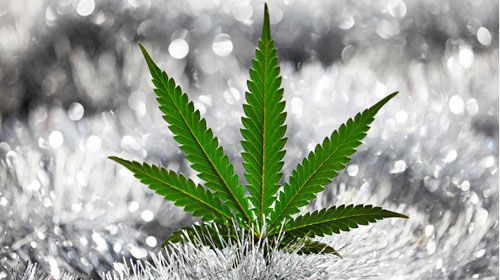|

by Stephen C. Webster
July 3, 2012
from
RawStory Website
Spanish version

A leaf from a
marijuana plant.
A
government-sponsored study published recently
in The Open Neurology Journal concludes that marijuana
provides much-needed relief to some chronic pain sufferers and that
more clinical trials are desperately needed, utterly destroying the
U.S. Drug Enforcement Agency’s (DEA) classification of the drug as
having no medical uses.
While numerous prior studies have shown marijuana’s usefulness for a
host of medical conditions, none have ever gone directly at the
DEA’s placement of marijuana atop the schedule of controlled
substances.
This study, sponsored by the State of
California and conducted at the University of California Center for
Medicinal Cannabis Research, does precisely that, driving a stake
into the heart of America’s continued war on marijuana users by
calling the Schedule I placement simply “not accurate” and “not
tenable.”
Reacting to the study, Paul Armentano, director of the
National Organization for the Reform of Marijuana Laws (NORML),
told Raw Story that the study clearly proves U.S. drug policy,
“is neither based upon nor guided by
science.In fact, it is hostile to science,” he said.
“And despite the Obama
Administration’s well publicized 2009 memo stating, ‘Science and
the scientific process must inform and guide decisions of my
Administration,’ there is little to no evidence indicating that
the federal government’s ‘See no evil; hear no evil’ approach to
cannabis policy is not changing any time soon.”
Schedule I is supposedly reserved for
the most inebriating substances that the DEA believes have no
medical value, including LSD, ecstasy, peyote and heroin.*
* Clarification:
Scientific studies have shown
LSD, ecstasy,
peyote and
heroin also have some limited
medical value, which the DEA has refused to recognize.
As the
DEA describes it:
“Drugs listed in schedule I have no
currently accepted medical use in treatment in the United States
and, therefore, may not be prescribed, administered, or
dispensed for medical use. In contrast, drugs listed in
schedules II-V have some accepted medical use and may be
prescribed, administered, or dispensed for medical use.”
And that’s the problem, the study’s
authors portend.
“The classification of marijuana as
a Schedule I drug as well as the continuing controversy as to
whether or not cannabis is of medical value are obstacles to
medical progress in this area,” they wrote.
“Based on evidence currently
available the Schedule I classification is not tenable; it is
not accurate that cannabis has no medical value, or that
information on safety is lacking. It is true cannabis has some
abuse potential, but its profile more closely resembles drugs in
Schedule III (where codeine and dronabinol are listed). The
continuing conflict between scientific evidence and political
ideology will hopefully be reconciled in a judicious manner.”
They add that their evidence showed
marijuana reliably reduced chronic neuropathic pain and muscle
spasticity due to multiple sclerosis versus trials where a placebo
was used.
They also specifically tested
marijuana’s effects when smoked, calling the delivery method “rapid
and efficient” but noting that vaporization is a better choice
because it produces less carbon monoxide.
The study adds that, like all medicines, there are negative side
effects associated with marijuana, such as dizziness, fatigue,
lightheadedness, muscle weakness and pain and heart palpitations -
all of which can pose a risk in some chronic pain patients with
co-occurring conditions like cardiovascular disease or substance
abuse disorders.
However, they call these side effects,
“dose-related” and “of mild to
moderate severity,” adding that they “appear to decline over
time, and are reported less frequently in experienced than in
naïve users.”
Researchers also noted that,
“fatal overdose with cannabis alone
has not been reported.”
Authors additionally found that
marijuana does cause withdrawal symptoms within 12 hours of use,
noting the symptoms are mild in experienced users and typically
abate within 72 hours.
They added that ingesting marijuana “can
acutely impair skills required to drive motor vehicles,” but noted
that the data on marijuana and traffic accidents is “inconclusive.”
Ultimately, they concluded that more clinical trials are needed to
determine which individual components of the marijuana plant are
causing the medicinal effects, and whether the plant can be used to
treat a host of other ailments.
“Medical marijuana is mostly used
for
chronic pain, and has enabled
countless patients to either reduce or eliminate their
pharmaceutical drug regimen,” Kris Hermes, a spokesman for
Americans for Safe Access (ASA),
one of the nation’s leading medical marijuana advocacy groups,
told Raw Story.
“However, it can also be used for:
arthritis, nausea or as an
appetite stimulant for people living with
HIV/AIDS or
cancer,
gastrointestinal disorders, and
movement disorders (not just
for people with multiple sclerosis). That is only a sampling of
health conditions for which cannabis has been found helpful in
alleviating symptoms.
Other health conditions include:
[post-traumatic stress disorder], [attention deficit disorder],
[attention deficit hyperactivity disorder] and other mental
health conditions, glaucoma, and migraines.”
In hopes of forcing recognition of
marijuana’s medical value, ASA sued the federal government last year
after a long-running appeal for the reclassification of marijuana
was
shot down nearly a decade after it was filed.
That case should go before the U.S.
Court of Appeals District of Columbia Circuit later this year.
“The federal government’s strategy
has been delay, delay, delay,” ASA chief counsel Joe Elford
said in an advisory.
“It is far past time for the
government to answer our rescheduling petition, but
unfortunately we’ve been forced to go to court in order to get
resolution.”
“Reform advocates can and should use this study to show their
congressional representatives that our country’s leading medical
marijuana researchers agree that it should be reclassified,”
Hermes added.
“…This certainly should also have a
bearing on the D.C. Circuit’s deliberations in the appeal of the
rescheduling petition denial.”
Medical marijuana is currently legal in
just 17 states and Washington, D.C.
|

